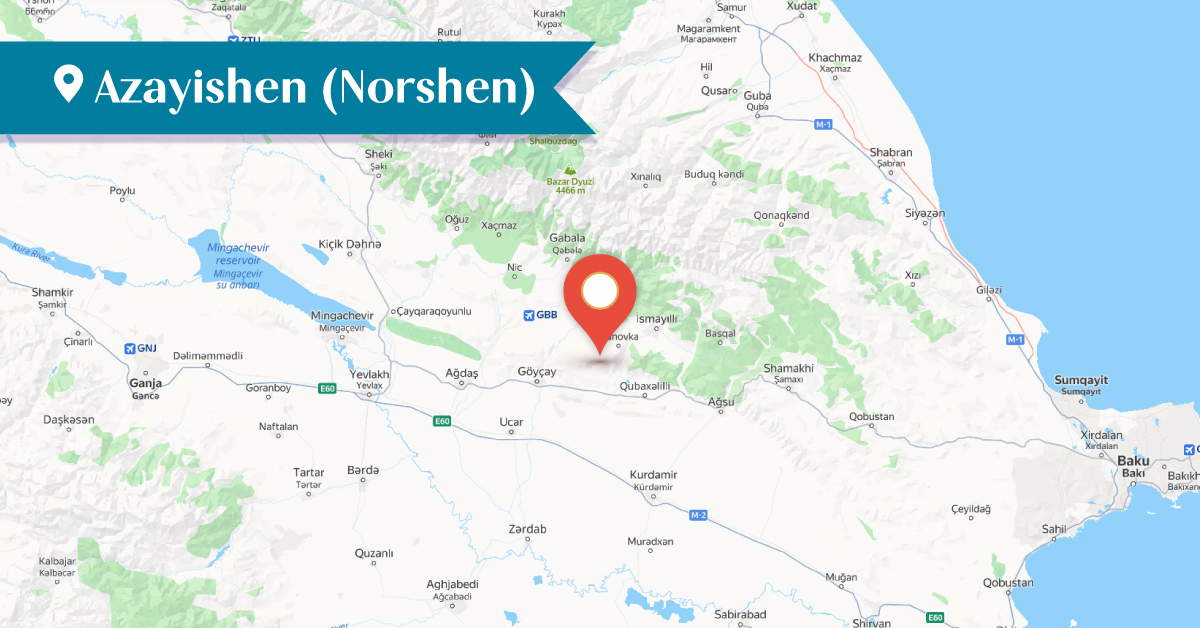2025
2025
2025-06-23

The village of Azayishen (Norshen) in the Ismayilli district was located about 18 km southwest of the district center. Being a relatively new settlement, it was called Norshen (“New Village”), and also Zayishen. The inhabitants had migrated from the Khachen, Varanda, and Jraberd regions of Artsakh.
In 1861, the village had 55 Armenian households. During the visit of Bishop Makar Barkhudaryants in 1890, the village had 83 Armenian households with a population of 693. By 1914, all 879 residents of Azayishen were Armenians
In 1907, a school building was constructed in the village, with an inscription carved on the stone above the entrance.
Ayib, ben, Azay shen, 1907.
In the summer of 1918, the Turkish army invaded the village and massacred the population. Some of the villagers organized a heroic self-defense. Harutyun Ohanyan, Grigor Manucharyan, and Alahveran Ohanyan demonstrated courage in these fights. The tombstone of the latter was located in the village cemetery with the following inscription:
This is the tombstone of Alahveran Ohanyan, b. 1865, d. 1918.
After the establishment of Soviet rule in Azerbaijan, the survivors of the massacres from Azayishen returned to their native village. According to data from 1924, Azayishen was home to 35 Armenian households (155 residents).
During the Soviet years, the village had an Armenian eight-year school, which was closed after 1984.
In 1988, the village was inhabited by 70 Armenian households with a population of 170, who were forcibly displaced in December of the same year.
Azayishen had a church named Surb Astvatsatsin (Holy Mother of God), which has not been preserved. During the visit of monument specialist Samvel Karapetyan in 1984, the village cemetery was still intact, containing numerous inscribed tombstones dating to the 19th century.
S. Karapetyan published the inscription of the oldest preserved tombstone in the Azayishen cemetery, dating back to 1796.
This is the tombstone of Daniel, son of Mravach Yekan, 1796.
Clergymen were also buried in the village cemetery:
May God have mercy on Ter Sargis Harutyunyan, 1875.
This is the tombstone of Ter Hovhannes, who was the son of Ter Sargis Harutyunyan, 1862.
In the 1960s, three water reservoirs were built in Azayishen. On the frontal stone of the reservoir located on the southern edge of the village, the following inscription was carved:
In memory of Sanvel Tavaryants, 1908.
The village is now called Sultankend and is inhabited by Azerbaijanis.
Bibliography
Barkhutaryants M., Land of Aghvank and its Neighbors: Artsakh, Yerevan, 1999.
Karapetyan S., The Armenian Lapidary Inscriptions of Aghvank Proper, Yerevan, 1997.
Karapetyan, S., Aghvank Proper, Part 1, Yerevan, 2024, pp. 86-95.